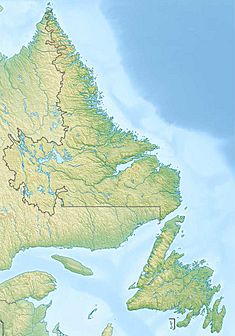Twin Falls (Newfoundland and Labrador) facts for kids
Quick facts for kids Twin Falls Hydroelectric Power Station |
|
|---|---|
|
Location of Twin Falls Hydroelectric Power Station in Canada Newfoundland and Labrador
|
|
| Location | Canada Newfoundland and Labrador |
| Coordinates | 53°29′47.5″N 64°30′59.4″W / 53.496528°N 64.516500°W |
| Construction began | 1960 |
| Opening date | 1963 |
| Construction cost | $47,500,000 |
| Owner(s) | Newfoundland and Labrador Hydro |
| Reservoir | |
| Creates | Ossokmanuan Reservoir |
| Power station | |
| Decommission date | 1974 |
| Turbines | 7 |
| Installed capacity | 225 MW |
The Twin Falls site was once home to a special power station. This station used the power of moving water to make electricity. It was built by a company called the British Newfoundland Development Corporation (Brinco). Their main goal was to provide electricity to big mining operations in places like Labrador City and Wabush.
What is the Twin Falls Power Station?
The Twin Falls power station was a hydroelectric plant. This means it used water to create electricity. It was located on the Unknown River. This river flows into the Churchill River in central Labrador, Canada.
Building the Power Plant
Work on the Twin Falls power station began in 1960. To make electricity, the river needed to be controlled. So, a dam was built at Twin Falls. This dam created a large body of water called the Ossokmanuan Reservoir.
The power station was finished in 1963. It was very powerful, able to produce 225 megawatts (MW) of electricity. To send this power to the mines, two long power lines were built. These lines were about 115 miles (185 kilometers) long. They carried electricity at a very high voltage, 230,000 volts. Building the entire project cost about $47.5 million back in 1963.
Twin Falls and the Churchill Falls Project
The electricity from Twin Falls was very important. It helped with the building of an even bigger power project nearby, called Churchill Falls. Twin Falls provided the electricity needed during the early construction of that huge project. It also helped open up the area for more development.
However, as plans for Churchill Falls grew, engineers realized something important. They could make much more electricity by moving the water from the Ossokmanuan Reservoir. If this water flowed into the Smallwood Reservoir and then to the Churchill Falls plant, it could make about three times more electricity.
So, in July 1974, the Twin Falls plant was shut down. The water from its reservoir was then sent to the Smallwood Reservoir. This was done as part of an agreement with the Churchill Falls Labrador Corporation Limited (CFLCo).


